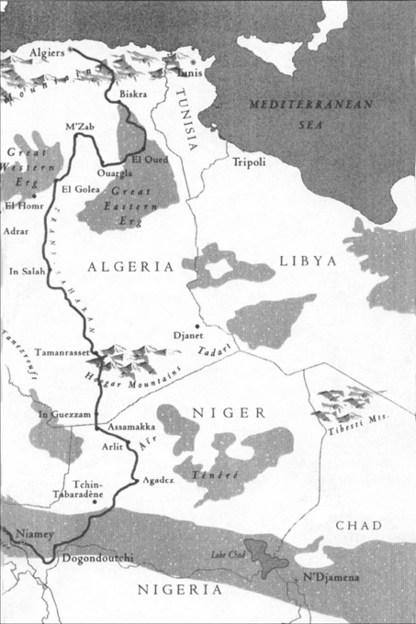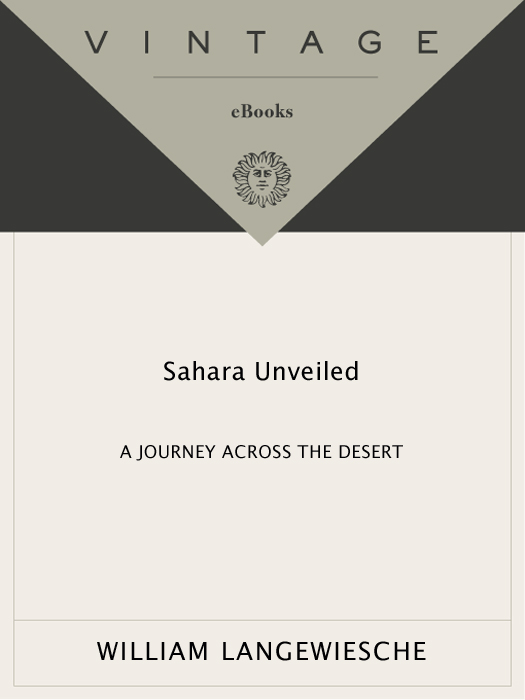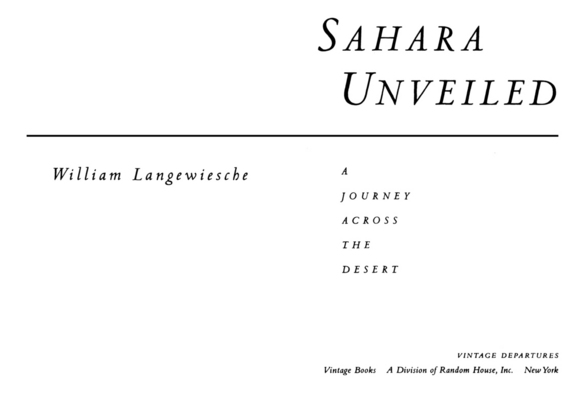ACCLAIM FOR
William Langewiesches
Sahara Unveiled
Whether dealing with the geography and history of the region, observing its psychological impact on the natives and outsiders, describing the beauty of its swirling sand patterns or discoursing on the characteristics of the scorpion Langewiesche writes with style and flair. This is travel writing with a human face.
Parade magazine
Langewiesche exploits the harshness, forlornness, and political hopelessness of the vast desert to fashion an entertaining and edifying tale.
The New York Times
A readers dream. With spare lyrical cadences and cool sensuality, Langewiesche summons up the landscape itself. Sahara Unveiled has a masterful dry chill to it, a power that stays coiled and ready to spring and a prose that fits its subject as cleanly as skin to the bone.
Seattle Times
Like Charles Doughty, Freya Stark, T. E. Lawrence, Antoine de Saint-Exupry, Wilfred Thesiger, and many others Langewiesche finds places of his own amid the vast mysteries of the desert. His travels are filled with intense characters and scenes so vivid you can feel the grit between your teeth.
The Advocate Literary Supplement
BOOKS BY
William Langewiesche
Cutting for Sign
Sahara Unveiled

William Langewiesche
Sahara Unveiled
William Langewiesche is the author of Cutting for Sign and a correspondent for The Atlantic Monthly. For many years a commercial pilot, he now lives in Davis, California.



FIRST VINTAGE DEPARTURES EDITION, JULY 1997
Copyright 1996 by William Langewiesche
All rights reserved under International and Pan-American Copyright Conventions. Published in the United States by Vintage Books, a division of Random House, Inc., New York, and simultaneously in Canada by Random House of Canada Limited, Toronto. Originally published in the United States in hardcover by Pantheon Books, a division of Random House, Inc., New York, in 1996.
Portions of Sahara Unveiled have appeared in The Atlantic Monthly.
Grateful acknowledgment is made to the following for permission to reprint previously published material:
Chapman & Hall: Excerpts from The Physics of Blown Sand & Desert Dunes by R. A. Bagnold (New York: William Morrow & Company, 1942).
Reprinted by permission of Chapman & Hall.
Editions Jean-Claude Lattes: Excerpts translated by William Langewiesche from Touareg, La Tragedie by Mano Dayak. Copyright 1992 by Editions Jean-Claude Lattes. Reprinted by permission of Editions Jean-Claude Lattes.
Illustration credits: Photographs on ,
copyright E. D. McKee/ U.S. Geological Survey; photograph on , copyright Eric Lessing/ Art Resource, N.Y.
Map 1995 by Vikki Leib.
The Library of Congress has cataloged the Pantheon edition as follows: Langewiesche, William.
Sahara unveiled : a journey across the desert / William Langewiesche. p. cm.
1. SaharaDescription of travel.
2. Langewiesche, WilliamJourneysSahara. I. Title.
DT333.L26 1996
916.604329dc20
95-48864
eISBN: 978-0-307-78066-9
Author photograph courtesy of William Langewiesche
Random House Web address: http://www.randomhouse.com/
v3.1
ACKNOWLEDGMENTS
Thanks to Dan Frank, Cullen Murphy, Chuck Verrill, and Bill Whitworth for their years of support. Thanks also to Gail Boyer Hayes for her enduring faith and her intelligence. Finally thanks to the Saharans themselves, among whom I count close friends. I have judged them frankly. I know they will understand.
To Minouche
CONTENTS
PART I
T HE N ORTH
I S A D ESERT
1
BEFORE
THE
DESERT
D O NOT REGRET the passing of the camel and the caravan. The Sahara has changed, but it remains a desert without compromise, the world in its extreme. There is no place as dry and hot and hostile. There are few places as huge and as wild. You will not diminish it by admitting that its inhabitants can drive, and that they are neither wiser nor purer nor stronger than you. It is fairer to judge them squarely as modern people and your equals. They were born by chance in a hard land, at a hard time in its history. You will do them no justice by pretending otherwise. Do not worry that their world, or yours, has grown too small. Despite its roads, its trucks, its televisions, the Sahara remains unsubdued.
In its scale and complexity, it is a difficult place to know. Consider just the external dimensionsa desert the size of the United States, filling the northern third of Africa, extending south nearly to the edge of the tropical forests. Only a fifth of this vastness is the sand of popular imagination, formed into the great dune seas called ergs in Arabic; the rest is rock and gravel plain, and high rugged mountain. On that much we can agree. But beyond such crude description, geographers begin to quarrel over the most basic measures. For instance, if desert is defined by dryness, should the threshold be six inches of yearly rain, or twice that? Should desert be defined by variability of rainfall? By rates of evaporation? By hours of sunshine? Or should we choose a biological standard and define the Sahara as a place where only certain plants and animals can survive? If the questions seem endless, it is because the desert defies such delimitations. You cannot even assume you will know it when you see it. My own impression is that the Sahara is indeed advancing south into Africa, despite the evidence from satellite surveys that perhaps it is not. The satellites measure temperature, soil, and vegetation. But my measure is mostly human. It starts far to the north, in Algiers, a port city on North Africas green coastal plain, which at first glance is not the Sahara at all.
Algiers was once the loveliest city of the French colonial empire. As the capital of an independent Algeria now, it still sparkles across hills above a blue Mediterranean bay. It has a whitewashed center with boulevards lined by stuccoed French-style apartment buildings, and a gentle climate nurtured by maritime breezes. The Sahara proper lies a day south by bus, across a farmed coastal plain, and out beyond the snowy Atlas Mountains. Visitors mention the deserts pull, the fabled attraction of that imagined horizon. They say the Sahara has the presence of an unseen ocean. That is true. But you can also find the desert closer, in the poverty and crowding of Algiers.















